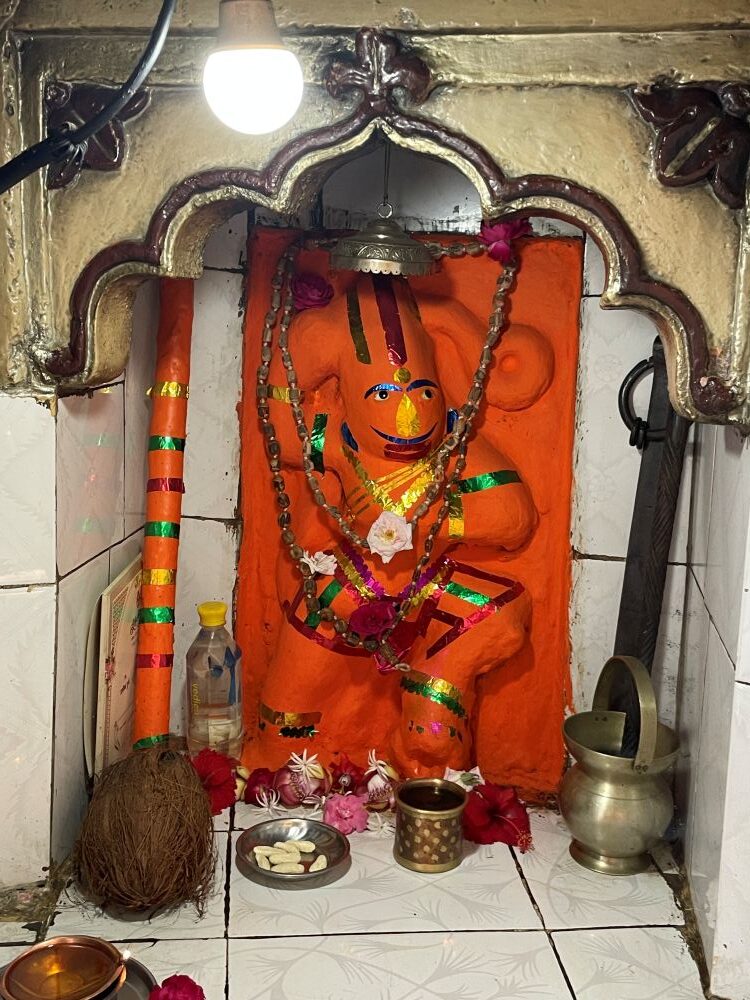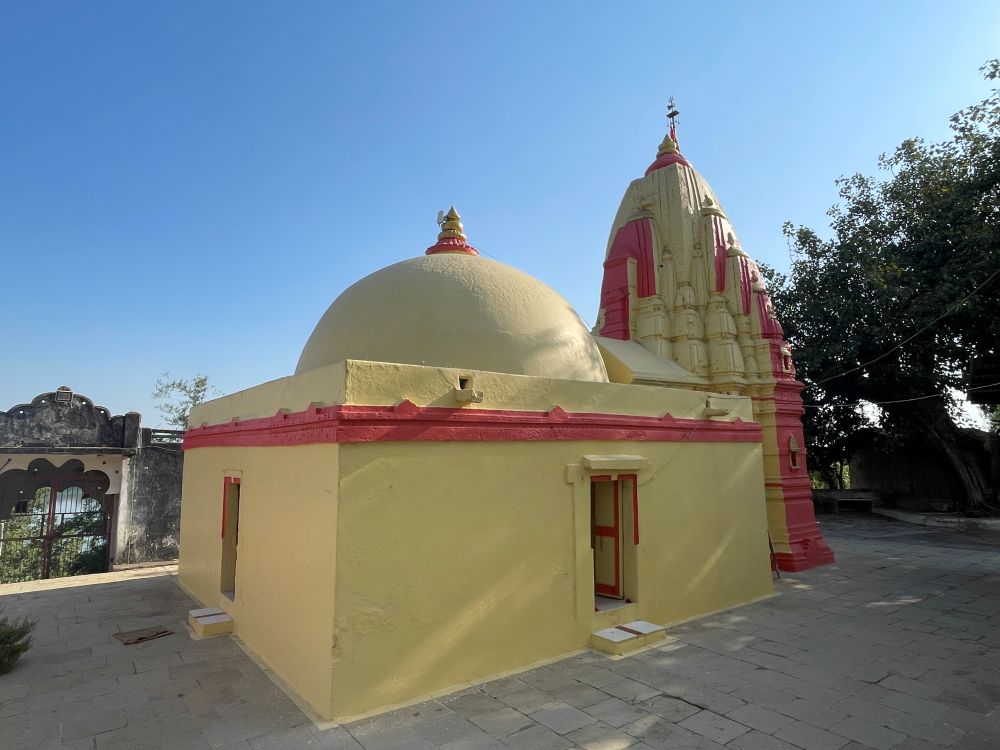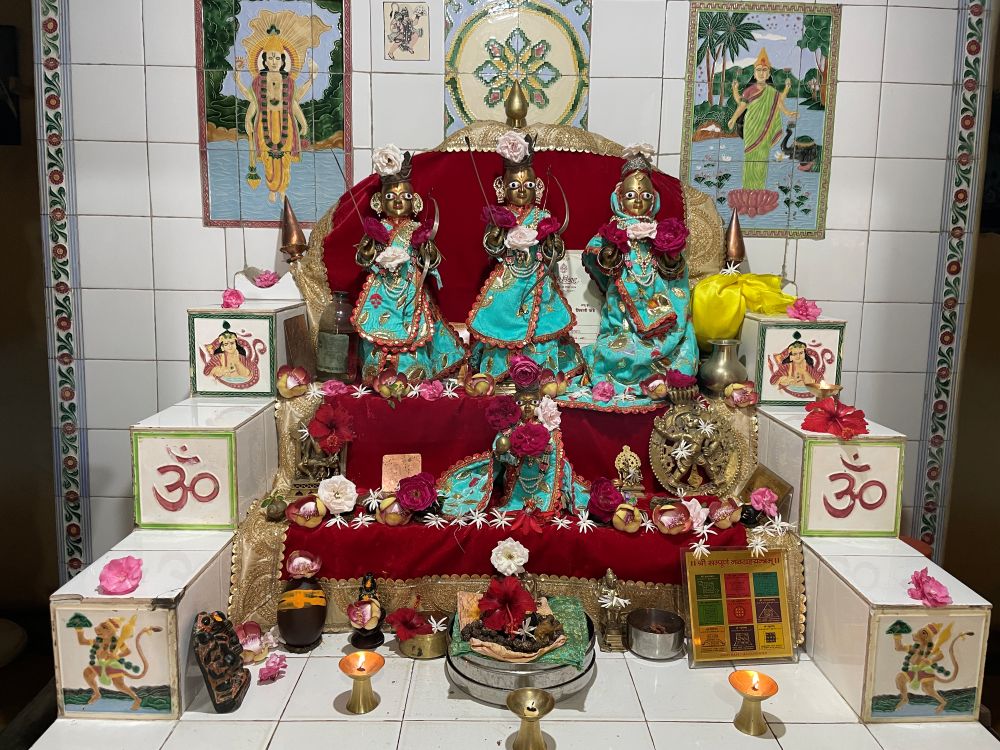 Meghanad, Atikaya, Akshakumar, Narantaka, Devantaka, and Trishira are the sons of Dashanan Ravana. Amongst them Hanuman killed Akshakumar. It is believed that Hanuman performed penance at the site of the Hanumanteshwar Mahadev Temple to atone for the sin (Brahmahatya) incurred from this act. The temple houses powerful spiritual instruments like Shakti Yantra and Shiva Yantra. It is also said that one of the chillums (smoking pipes) of Saint Gajanan Maharaj is with the priests of this temple. Devotees believe that praying here absolves the sin of Brahmahatya. Many devotees, including those undertaking the Narmada Parikrama pilgrimage, visit this sacred site.
Meghanad, Atikaya, Akshakumar, Narantaka, Devantaka, and Trishira are the sons of Dashanan Ravana. Amongst them Hanuman killed Akshakumar. It is believed that Hanuman performed penance at the site of the Hanumanteshwar Mahadev Temple to atone for the sin (Brahmahatya) incurred from this act. The temple houses powerful spiritual instruments like Shakti Yantra and Shiva Yantra. It is also said that one of the chillums (smoking pipes) of Saint Gajanan Maharaj is with the priests of this temple. Devotees believe that praying here absolves the sin of Brahmahatya. Many devotees, including those undertaking the Narmada Parikrama pilgrimage, visit this sacred site.
 Legend states that when Hanuman went to Lanka in search of Seeta, Ravana ordered his youngest son Akshakumar to teach Hanuman a lesson. Valmiki Ramayana’s Sundarkand (Canto 27) describes Akshakumar’s extraordinary bravery. At one point, Hanuman hesitated, feeling he should not kill such a
Legend states that when Hanuman went to Lanka in search of Seeta, Ravana ordered his youngest son Akshakumar to teach Hanuman a lesson. Valmiki Ramayana’s Sundarkand (Canto 27) describes Akshakumar’s extraordinary bravery. At one point, Hanuman hesitated, feeling he should not kill such a
courageous warrior. However, realizing “a growing fire cannot be ignored” (Na vardhamāno’gnirupekṣituṁ kṣamaḥ), Hanuman first killed Akshakumar’s horses and destroyed his chariot. When Akshakumar flew into the sky, Hanuman seized him by the feet and smashed him onto the earth, causing his body to shatter into pieces.
Later, after returning to Ayodhya, Hanuman sought permission from Lord Ram to visit Lord Shiva at Mount Kailash. However, Nandi denied him entry, stating that Hanuman had incurred the sin of Brahmahatya by killing Ravana’s son. Nandi instructed Hanuman to bathe in the Narmada (Rewa) River and perform penance on its banks. Obeying these instructions, Hanuman meditated here for several years. Pleased with his devotion, Shiva appeared and instructed Hanuman to establish a Shivalinga named Hanumanteshwar Mahadev, proclaiming that those who worship here would be absolved of the sin of Brahmahatya. Hanuman then established the Shivalinga.
The Hanumanteshwar temple is one of the ancient temples  in Narmada district, known for its peaceful and serene environment. Located by the banks of the Narmada River, the temple complex is surrounded by fortified walls and numerous trees. Several ancient Shivlingas lie near a particular tree. In front of the temple, there are memorials (Samadhis) and footprints (Padukas) of many saints and ascetics. Nearby, temples dedicated to Hanuman and Ram can also be found. Unlike typical depictions holding a mountain and mace, here, Hanuman’s idol is meditative, with his left hand on his chest and right hand on his forehead, signifying his penance at this site.
in Narmada district, known for its peaceful and serene environment. Located by the banks of the Narmada River, the temple complex is surrounded by fortified walls and numerous trees. Several ancient Shivlingas lie near a particular tree. In front of the temple, there are memorials (Samadhis) and footprints (Padukas) of many saints and ascetics. Nearby, temples dedicated to Hanuman and Ram can also be found. Unlike typical depictions holding a mountain and mace, here, Hanuman’s idol is meditative, with his left hand on his chest and right hand on his forehead, signifying his penance at this site.
The temple features numerous spires and sub-spires. Its facade contains many small shrines, and its structure comprises a Sabha Mandap (assembly hall), Antarala (vestibule), and Garbhagriha (sanctum sanctorum). The Sabha Mandap has a white idol of Nandi and a seated idol of Ganesh, covered in vermilion. Another idol of Ganesh is placed in the Antarala. The entrance to the Garbhagriha features Kirtimukh at the bottom and an idol of Ganesh at the center of the lintel (laltbimba), topped by a large serpent skin frame. Due to the deep sanctum, devotees descend steps to reach the Shivling, sheltered by a serpent canopy, with continuous water (Abhishek) flowing from above. A deity of Goddess Parvati is placed behind the Shivling.
comprises a Sabha Mandap (assembly hall), Antarala (vestibule), and Garbhagriha (sanctum sanctorum). The Sabha Mandap has a white idol of Nandi and a seated idol of Ganesh, covered in vermilion. Another idol of Ganesh is placed in the Antarala. The entrance to the Garbhagriha features Kirtimukh at the bottom and an idol of Ganesh at the center of the lintel (laltbimba), topped by a large serpent skin frame. Due to the deep sanctum, devotees descend steps to reach the Shivling, sheltered by a serpent canopy, with continuous water (Abhishek) flowing from above. A deity of Goddess Parvati is placed behind the Shivling.
At the temple’s backside, a bathing ghat named Morani Sangam is built along the Narmada River. Legend narrates that the area was populated by peacocks, frequently hunted for meat. Hunters once killed a peahen, consumed its meat, and discarded the bones. A bird, carrying a bone fragment, flew northwards and dropped it at the ghat after being attacked by other birds, granting liberation to the peahen, who was reborn as a princess. She later remembered her past life and informed her father, the king, who then performed rituals at the ghat to liberate other peacocks, including her former mate.
Many devotees visiting the temple bathe in the Narmada. Saints and ascetics have performed water-burials (Jalsamadhi) here. It is also said that the ashes of Mahatma Gandhi, former Prime Ministers Indira Gandhi and Rajiv Gandhi were immersed here. The temple priests possess a chillum once belonging to Saint Gajanan Maharaj of Shegaon. One priest’s ancestor, addicted to cannabis, was reportedly cured after smoking from this chillum offered by Gajanan Maharaj.
